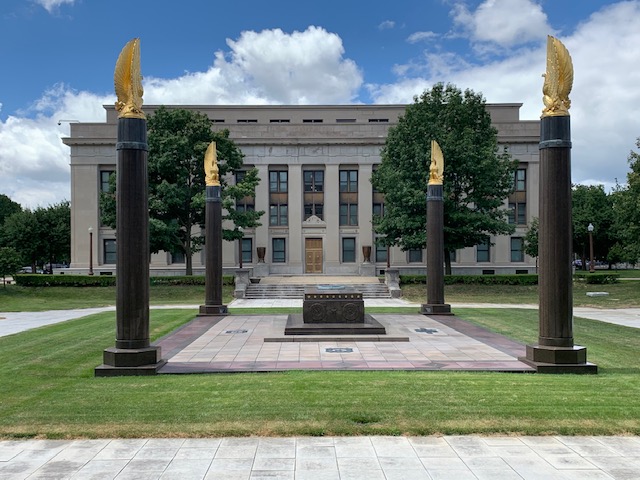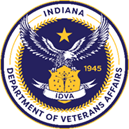American Legion’s first home now site of Indiana Veterans Center
by Kirsten Clark
INDIANAPOLIS – On March 15, 1919, members of the American Expeditionary Force convened in Paris to form the first American Legion caucus. This historic event marked the start of an organization dedicated to creating and fighting for veteran benefits, resources and programs, and also marked the start of a legacy of caring for veterans in the state of Indiana.
The group’s war-weary veterans held their first convention in November 1919 in Minneapolis. They adopted a constitution and preamble and voted to establish a permanent national headquarters, moving the newly named American Legion from Washington, D.C., to Indianapolis, Ind. With more than 170 trains in and out of the Circle City on a daily basis, Indianapolis provided the ideal location for 55 department heads to meet and create the programs that would change the lives of American veterans and their families forever.
“A special Indiana legislative session in 1920 actually designated two city blocks on state property and funneled $2.2 million to construct what is now the Memorial Mall, a part of which Building 777 now stands,” said J. Stewart Goodwin, Indiana War Memorial executive director and retired U.S. Air Force brigadier general. “They initially sought to use the property to honor the nearly 135,000 Hoosier veterans and 3,709 killed in action.”
The state moved to begin building the Indiana War Memorial, located on Michigan Street, and Building 777, located on Meridian Street, on this allocated property. Building 777 was the first structure conceived on the state land, breaking ground in 1924. In 1927, General John J. “Black Jack” Pershing, commander of American Expeditionary Forces on the Western Front during World War I, laid the cornerstone of the Indiana War Memorial, launching the development of additional memorials standing in that space today. The American Legion Mall itself, located behind Building 777, features a sunken garden with a cenotaph and four Art Deco columns topped with stylized golden eagles. Built in 1931, this cenotaph is a tribute to the Hoosiers who gave their lives in World War I.

“Indianapolis has more memorials and space dedicated to our service members and veterans than any other city in America, except Washington, D.C.,” Goodwin said. “This area did eventually serve as the World War I tribute city planners had intended on.”
After the building’s construction was complete in 1925, the American Legion took up residence in the four-story, 40,000 square foot iconic structure. The American Legion Auxiliary also began serving women veterans from Building 777 in the years following. The location was so successful that by 1950, the Legion had outgrown the building and moved to a new, larger location nearby at 700 N. Pennsylvania St.
“We are now in a position to put this historic site back to work in a way that will provide tremendous benefit to veterans and eligible family members,” said Dennis Wimer, IDVA director. “The vision we have is to make Building 777 the nucleus of veteran activity, resources and strength in Indiana. Veterans will be able to access the help and resources they need in one location, one trip, one stop.”
The distinctive and unique building needed a transforming renovation before it could be made into the Indiana Veterans Center. The vision was to preserve all the detail of its early 1920s charm and architecture. Then-Gov. Mike Pence appropriated funds from a 1923 state account that allocated monies for maintaining, building and recovering state properties but remained unused until labor to revive the site began. While the historic look of the building has been preserved, new features include updated ramps compliant with the Americans with Disabilities Act, new elevators and restrooms on each floor. Renovations also included updated wiring, dry wall repair, breakrooms with appliances, new carpeting and an HVAC system. Now that the renovation is complete, all divisions of IDVA have migrated to the building’s third floor. IDVA divisions include the State Approving Agency (SAA), the Military Family Relief Fund, State Veteran Service Officers, Training and Services, Legal and Legislative, and Communications and Outreach. It is also a hub for the state’s six District Service Officers and two veteran representatives from the Indiana Department of Workforce Development.
In those early days of the American Legion’s presence in Building 777, the Servicemen’s Readjustment Act of 1944, commonly known as the GI Bill of Rights, began its journey to completion within its walls. The very first pages of that famous document were constructed here by Harry W. Colmery, a former national commander of the American Legion, and introduced to Congress and signed into law by President Franklin D. Roosevelt in June 1944. While a determined American Legion sought better benefits for men and women returning to civilian life after World War II, the bill was originally designed to assist veterans in gaining education and training, loan guaranty for homes, farms or businesses, and unemployment pay. Nearly 9 million veterans would take advantage of the GI Bill between 1944 and 1949, with provisions extended into 1956. Changes made in 1966 would extend those benefits to peacetime veterans. Many other veteran benefits and resources now offered by the U.S. Department of Veterans Affairs began with the ideas from leaders housed in Building 777.

Additional veteran helping agencies who are scheduled to set up shop in the Indiana Veterans Center are INVets, Operation Job Ready Vets, Welcome Home Vietnam Veterans, representatives from the Volunteers of America (VOA), Disabled American Veterans (DAV) and the American Legion (AL). Furthermore, the location will assist veterans with their medical and health care enrollment and other Federal benefits, as part of the U.S. Department of Housing and Urban Development-VA Supportive Housing Program (HUD-VASH). HUD-VASH is a collaborative program between HUD and VA which combines HUD housing vouchers with VA supportive services to help veterans who are homeless and their families find and sustain permanent housing. Representatives from the Federal Regional office are on hand to assist veterans in acquiring this benefit and associated services offered from the U.S. Department of Veterans Affairs.
“No other state that we know of will offer all of these services under one roof,” said Goodwin. “Since the Vietnam War, every veteran is a volunteer; they raised their hands and took an oath to protect and defend others. It is our responsibility to take care of those who took care of us.”
Building 777 also has improved technology access and increased space for training, staff meetings and conferences. Veterans will be able to use computers and the internet to access any digital and electronic records with assistance from staff. The fourth floor features an auditorium with the original restored hand-carved wood wainscoting and wall panels, as well as additional office work space that can be leased for designated periods of time through the Indiana Department of Administration.
“The Indiana Veterans Center is a veteran’s first and last stop,” Wimer said. “If you are a veteran or veteran family member looking for assistance, you can come here and we will do our best to meet your needs. Our goal is to serve Indiana’s veterans in the best possible way, and I know we can do that at the Indiana Veterans Center.”
Some information for this article obtained from https://www.legion.org/history and va.gov. Special thanks to the Indiana War Memorial staff for their assistance in researching the Indiana Archives for information about the construction and occupancy of Building 777.
-30-
